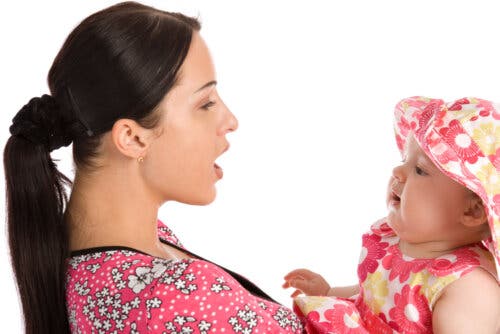Evolutionary Linguistics: Characteristics of the Pre-Linguistic Stage

From birth, babies communicate through the senses. During their first year of life, their language evolves from simple articulatory exercises to the emission of their first meaningful words. We’re talking about the pre-linguistic stage. Keep reading to learn all about it.
Evolutionary linguistics: Characteristics of the pre-linguistic stage
The pre-linguistic and linguistic stages are the two stages of language development. The first covers the first 12 months of life, while the second stage begins with the first words and focuses on the language acquisition period, during which a child begins to integrate content (ideas) into forms (words).
During the first few months, language development is closely linked to the socialization process. Babies learn to communicate intentions not only through crying, but also through their gaze, gestures, and smiles.
This primary form of communication lays the foundations for subsequent verbal communication, in addition to contributing to the development of the attachment figure, which is essential in babies’ socio-affective development.

The pre-linguistic stage is organized in an evolutionary sequence that comprises four phases:
1st phase: Reflex vocalizations and “goo”-ing sounds (0-2 months)
During the first month of a baby’s life, they only emit reflex vocalizations or sound externalizations. With crying, the communicative process begins which, depending on the tone, denotes different needs: pain, hunger, cold, sleepiness, or a reflection of any state of well-being or discomfort. Crying allows babies to communicate their needs and, if they’re satisfied, they’ll use it intentionally.
Towards the second month, they begin to emit spontaneous sounds, called gurgles. The characteristic “gooing” sound.
2nd phase: Babbling and vocal play (3-6 months)
Starting in the third month, babies go from making isolated sounds to making voluntary and intentional sounds. They begin to constantly and clearly babble with guttural and vowel sounds, repeating the sounds “ga” and “goo.”
For them, it’s a kind of game, since they experiment with their speaking organs and start controlling them. At the same time, they have fun listening to their own voice. They like to scream to hear themselves and make purring-like sounds when they’re entertained with games.
Piaget considers that, during this phase, babies become aware that the phonations, gurgling, clapping, and guttural noises they make have an effect on their immediate surroundings. They learn to communicate this way, establishing relationships between what they emit and the effect that this produces around them.
3rd phase: Reduplicated babbling and imitation of sounds (6-9/10 months)
Through babbling and articulation games, babies dominate the emission of different vowel and consonant phonemes. Approximately at eight months, babies begin with polysyllabic sounds: “ba”, “pa”, “da”, “ga”, and “ma”, among others. In addition, they begin to repeat groups of words.
For example, they double syllables, saying things such as “mamama”, “bababa”, “papapa”, and “lalala.” In turn, these vocalizations lead the baby to utter their first words “by accident.”

From the sixth month on, babies begin to observe and imitate movements, sounds, and gestures. They show a special interest in listening to adults talk and they like to be listened and talked to. The interaction the baby seeks with adults confirms Bruner’s studies.
Bruner focused studies of language development on social interaction. In this regard, he considered that adequate interaction frameworks must be given for language learning to occur. Therefore, at this stage, adults must create communicative contexts so the baby can interact and evolve in their language.
4th phase: Intentional communication (9/10-12 months)
At the end of the first year, babies begin to communicate intentionally. They point to objects, say “no” with their head and “goodbye” with their hand, understand simple orders and, also, react when they hear their name.
From the age of one, polysyllabic sounds begin to have real meaning. Now they do call their mom and dad, they’re able to imitate animal sounds (“woof”, “meow”, or “moo”) and invent onomatopoeic words with meaning for them.
Family and adults play a very important role in language development. Thus, you have to lexically stimulate your child. In “conversations”, you should try to associate phonic meanings (spoken words) with meaning (objects the words refer to). This way, the child associates and establishes the relationship in their brain.
From birth, babies communicate through the senses. During their first year of life, their language evolves from simple articulatory exercises to the emission of their first meaningful words. We’re talking about the pre-linguistic stage. Keep reading to learn all about it.
Evolutionary linguistics: Characteristics of the pre-linguistic stage
The pre-linguistic and linguistic stages are the two stages of language development. The first covers the first 12 months of life, while the second stage begins with the first words and focuses on the language acquisition period, during which a child begins to integrate content (ideas) into forms (words).
During the first few months, language development is closely linked to the socialization process. Babies learn to communicate intentions not only through crying, but also through their gaze, gestures, and smiles.
This primary form of communication lays the foundations for subsequent verbal communication, in addition to contributing to the development of the attachment figure, which is essential in babies’ socio-affective development.

The pre-linguistic stage is organized in an evolutionary sequence that comprises four phases:
1st phase: Reflex vocalizations and “goo”-ing sounds (0-2 months)
During the first month of a baby’s life, they only emit reflex vocalizations or sound externalizations. With crying, the communicative process begins which, depending on the tone, denotes different needs: pain, hunger, cold, sleepiness, or a reflection of any state of well-being or discomfort. Crying allows babies to communicate their needs and, if they’re satisfied, they’ll use it intentionally.
Towards the second month, they begin to emit spontaneous sounds, called gurgles. The characteristic “gooing” sound.
2nd phase: Babbling and vocal play (3-6 months)
Starting in the third month, babies go from making isolated sounds to making voluntary and intentional sounds. They begin to constantly and clearly babble with guttural and vowel sounds, repeating the sounds “ga” and “goo.”
For them, it’s a kind of game, since they experiment with their speaking organs and start controlling them. At the same time, they have fun listening to their own voice. They like to scream to hear themselves and make purring-like sounds when they’re entertained with games.
Piaget considers that, during this phase, babies become aware that the phonations, gurgling, clapping, and guttural noises they make have an effect on their immediate surroundings. They learn to communicate this way, establishing relationships between what they emit and the effect that this produces around them.
3rd phase: Reduplicated babbling and imitation of sounds (6-9/10 months)
Through babbling and articulation games, babies dominate the emission of different vowel and consonant phonemes. Approximately at eight months, babies begin with polysyllabic sounds: “ba”, “pa”, “da”, “ga”, and “ma”, among others. In addition, they begin to repeat groups of words.
For example, they double syllables, saying things such as “mamama”, “bababa”, “papapa”, and “lalala.” In turn, these vocalizations lead the baby to utter their first words “by accident.”

From the sixth month on, babies begin to observe and imitate movements, sounds, and gestures. They show a special interest in listening to adults talk and they like to be listened and talked to. The interaction the baby seeks with adults confirms Bruner’s studies.
Bruner focused studies of language development on social interaction. In this regard, he considered that adequate interaction frameworks must be given for language learning to occur. Therefore, at this stage, adults must create communicative contexts so the baby can interact and evolve in their language.
4th phase: Intentional communication (9/10-12 months)
At the end of the first year, babies begin to communicate intentionally. They point to objects, say “no” with their head and “goodbye” with their hand, understand simple orders and, also, react when they hear their name.
From the age of one, polysyllabic sounds begin to have real meaning. Now they do call their mom and dad, they’re able to imitate animal sounds (“woof”, “meow”, or “moo”) and invent onomatopoeic words with meaning for them.
Family and adults play a very important role in language development. Thus, you have to lexically stimulate your child. In “conversations”, you should try to associate phonic meanings (spoken words) with meaning (objects the words refer to). This way, the child associates and establishes the relationship in their brain.
All cited sources were thoroughly reviewed by our team to ensure their quality, reliability, currency, and validity. The bibliography of this article was considered reliable and of academic or scientific accuracy.
- Acuña Robertson, X., & Sentis, F. (2004). Desarrollo pragmático en el habla infantil. https://repositorio.uc.cl/xmlui/bitstream/handle/11534/28705/Desarrollo%20pragm%C3%A1tico%20en%20el%20habla%20infantil.pdf?sequence=1
- Chavarría Conforme, R. L., & Jaramillo Torres, Y. M. (2021). Teorías del proceso de adquisición del lenguaje en niños de 0 a 3 años de edad (Bachelor’s thesis, Quito: UCE). http://www.dspace.uce.edu.ec/handle/25000/22578
- Magallanes Palomino, Y. V., Donayre Vega, J. A., Elias, G., Humberto, W., & Maldonado Espinoza, H. E. (2021). EL LENGUAJE EN EL CONTEXTO SOCIO CULTURAL, DESDE LA PERSPECTIVA DE LEV VYGOTSKY. https://revista.grupocieg.org/wp-content/uploads/2021/11/Ed.5125-35-Magallanes-Veronica-et-al.pdf
This text is provided for informational purposes only and does not replace consultation with a professional. If in doubt, consult your specialist.








